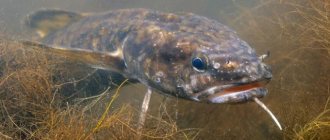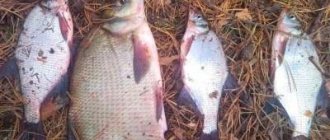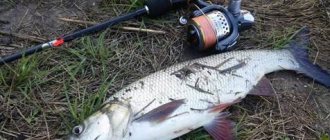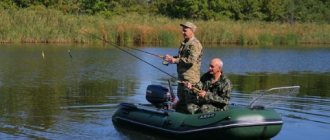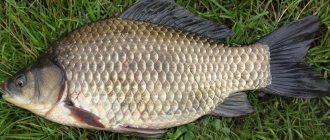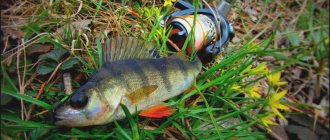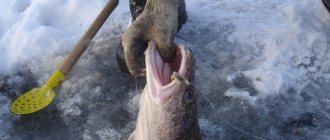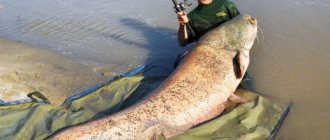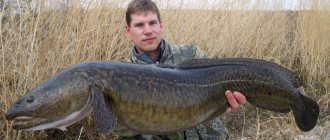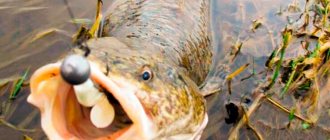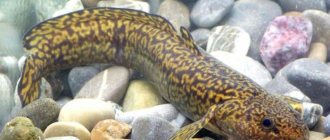Spring fishing for burbot on a donk
In spring, everything is the other way around - it is much more convenient to use donks than allowances.
It would seem: the same river, the same fish - what, exactly, is the difference? There is a difference, and a considerable one. Firstly, when catching burbot in the spring on a donk, it begins to bite very early, almost immediately after the ice drifts, when in the same places the fishing conditions are completely different than in the fall: the level of the rivers rises due to melt water, the current intensifies, and besides, it rushes along it all kinds of garbage washed away from the banks. Long tackle with a large number of hooks in such conditions is much more “saily” and carried away by the current: even if at first the line is positioned as expected, across the river, over time, floating plant stems, last year’s leaves, and other underwater debris stick to the main line and especially to the leashes , — the “windage” of the tackle increases and the sinker begins to crawl along the bottom.
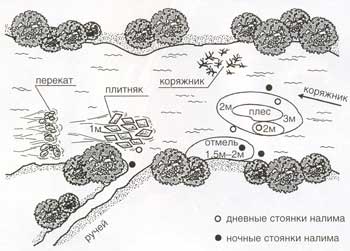
Secondly, burbot does not like to fight fast spring currents and often stays near the coast or in relatively calm places between two multidirectional streams, where a sharp bend of the coast forms a counter eddy current. Calm “spots” on a stormy spring river are usually small in size, and extra hooks on the gear are simply not needed.
Thirdly, when fishing in spring, fishermen are much less likely to stay on the reservoir all night than in autumn: it gets dark much later, everything around is damp, potential firewood is saturated with water, and for some reason the pre-dawn frosts seem colder than autumn frosts. Most anglers leave their gear overnight, and many who have a working day ahead of them check it not in the morning, but only the next evening. And an unattended undercut is much easier to detect than a donkey - for example, hooked with a hook when fishing with a float rod - and it can fall into the hands of those who like to remove prey from other people's gear, there are also such.
Tackle for catching burbot in spring
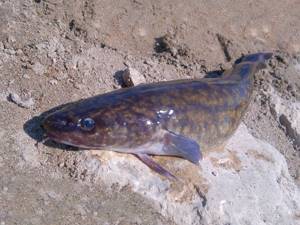
Photo 2. Spring burbot.
In the fishing world, it is generally accepted that catching burbot in the spring, and indeed at any other time of the year, is possible only with a donk. I can only agree that the donka is the most popular tackle for burbot fishing, but by no means the only one. Recently, a new direction has emerged - jig, and it is very promising, contrary to all skeptical expectations. But first things first.
Bottom fishing rod
Its design is not particularly important. This can be the simplest zakidushka, which is tied to a stick stuck into the bank or a coastal bush.
In the old days, in the spring, burbot was caught using simple gear, and even preschool children did this. My grandfather, whose childhood was spent in the outback of the village, on the banks of one of the tributaries of the Chusovaya, while still a boy, successfully hunted burbot for a simple snack. It was assembled from scrap materials - it was not a pity to tear it apart. Rope scaffolding, forged hook made of a nail, pebble. No bell - the gear was installed in the evening and checked in the morning. A small fish served as bait. Grandfather became keen on catching burbot quickly, and often brought home a fish whose head lay on his shoulder, and its tail dragged along the ground.
You can use feeder gear, or a spinning rod - all this is also great for catching spring burbot. Nevertheless, I give preference to zakidushki - for their simplicity, and for the ability to carry them fishing in “packs”.
Equipment device
To catch burbot on a donk, you don’t need particularly sophisticated equipment, however, there is one small nuance associated with the characteristic bite of this fish.
The burbot grabs the bait quietly and does not stand on ceremony with it for a long time - it swallows it almost immediately. Therefore, it often turns out that the bell begins to ring only when the fish has condemned the bait and gone home. The fisherman pulls the burbot ashore and fiddles for a long, long time to remove the swallowed hook, but in the end gives up on this matter - he cuts off the leash and attaches a new one.
To eliminate this unnecessary hassle, the equipment should be mounted with the ability to quickly change leads.
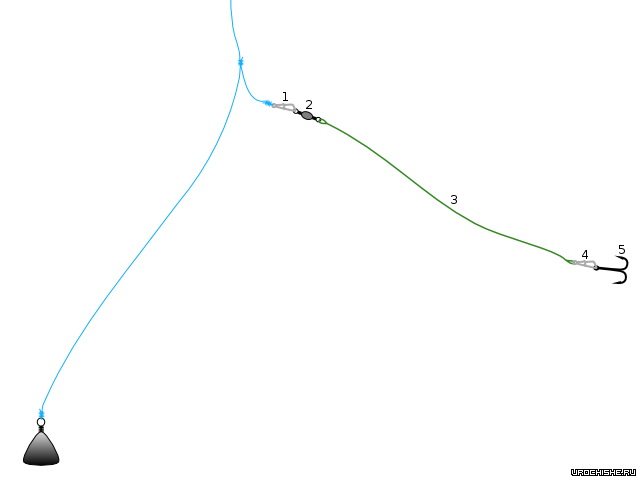
Rice. 1. Equipment for bottom fishing for burbot: 1 - clasp, 2 - swivel, 3 - leash, 4 - clasp for hook, 5 - hook.
However, it is advisable to use a tungsten leader.
If a hook with a burbot that has bitten is left unattended for a long time, the fish has some chance of grinding the line with its small teeth (even if it doesn’t grind it, it will ruin it). I know two such cases that happened to fishermen I knew. On top of everything else, if you are fishing with live bait, you must definitely install a tungsten leash, because no matter what the hour is, even a pike may bite.
It is best to use an elongated teardrop-shaped sinker - it is more difficult to catch in the rocks. The mass is chosen so that it is easier to cast and so that it does not get carried away by the current. 100 grams is enough.
Now about the parameters of the fishing line. It all depends on what kind of “monsters” are found in the place where you are fishing, but you should not use a very thin fishing line for equipment - the burbot is absolutely indifferent to its thickness. The most popular option for the Ural rivers:
- Main line: 0.5 mm;
- Sinker line: 0.3 mm (in case it gets stuck in the rocks - so as not to lose the leash with the hook);
- Leash: 0.3 mm (the part between the main line and the clasp).
Regarding the length. Fishing will be carried out in the coastal zone, so it makes no sense to spend a lot of fishing line on tackle. Usually 15-20 meters is enough for the eyes.
The burbot has a large mouth, so you shouldn’t waste time with hooks. I usually tie a hook of number 8 according to the Soviet classification; it is quite possible to use larger ones - up to number 10. It is advisable to have a longer forend - such a hook will be easier to pull out from the depths of the burbot throat.
Spinning (jig)
This type of burbot fishing is relatively new, and has not yet gained the required number of fans to be considered widespread. It's more exotic. Nevertheless, specialists who have mastered it are very good at carrying fish, including in spring water.
This method is not suitable for any river or terrain. Since we are dealing with a spinning rod and purely bottom-dwelling fish, it means we can only fish where the likelihood of a hook is excluded. Therefore, we will have to look for clean, pebble or sandy places, where the bottom is more or less smooth, without snags and other objects, where we can plant bait.
Standard stepped wiring will not work here either, burbot is not a pike perch or a pike perch, and it will not chase a fast bait (let alone rise after it). Therefore, they carry it out so that it “crawls” along the bottom - with the smallest steps (no higher than 20 cm), slowly. The noise made by the bait perfectly attracts fish. Here you have to “play” more with a rod than with a reel.
What to use as a “nozzle” - twisters or vibrating tails? As practice has shown, there is not much difference. However, some fishermen claim that silicone with attractants (so-called “edible rubber”) works much better than regular silicone.
Catching burbot with a jig is usually done at dusk - in the evening or in the morning, while it is still possible to control the cast visually. Some extreme sports enthusiasts also practice this in pitch darkness. But in my opinion, it’s better to spend a cold spring night by the fire, and entrust the catching of fish to the “automation” - the snookers.
Donkey rig for burbot
The donka (aka a snatch, a delivery) has been simplified to the limit so as not to grieve too much about the loss of gear:
- the main line with a diameter of 0.7 mm usually does not exceed 10–15 meters in length;
- a lead sinker of any shape and a pair of leashes 30–35 cm long and 0.5 mm thick are attached to it. (In fact, both the main fishing line and the leashes can be made twice as thin, the burbot will not break. But a thick fishing line gets tangled less at night, and the stronger the tackle, the fewer hooks it ends up breaking.)
- hooks are tied with single hooks No. 7 - No. 10, depending on the nozzle.
- a reel of arbitrary size and shape is made from a variety of materials: cut from wood, sawn from plywood or plastic. Some fishermen glue a strip of polypropylene foam along the reel to stick hooks into it, others stick hooks (there are from one to three of them on a burbot cast) into a separate piece of foam plastic.
Sometimes a reel with a pointed peg end is cut out of a board (usually linden, which is the easiest to work with), then on the pond you don’t have to look for something to securely attach the hook to. This design is sometimes simplified by driving two nails into a peg or screwing in two screws, onto which the fishing line is wound.
Such a design solution cannot be considered successful: the fishing line in places of contact with the corroding metal of nails or screws quickly loses strength; if you insulate the metal (for example, with pieces of cambric), then the wound fishing line, contracting when it dries, often bends the nails and tears the screws out of their sockets.
Since trinkets are usually displayed in considerable quantities, the task is to minimize their total weight and volume. Some fishermen, as in the case with subs, make sinkers for bottoms on the spot, from pebbles. Naturally, you can fish this way only in well-known reservoirs, and when going to new places, you still need to use traditional lead sinkers.
Another method to minimize the volume and weight of gear is to use multi-cell reels: from 10 to 15 reels are wound on one, usually of the same length. Since when installing gear stored in this way, the reel remains not on the pond, but in the fisherman’s backpack, then all the fishing line is used when casting, and there is no need for an extra supply (burbot fishing lines that are too long often get tangled in snags). On narrow forest rivers with a depth of no more than 2 m, a five-meter main line is quite sufficient; however, it is not a bad idea to have a skein of thick fishing line in stock so that, if necessary, you can quickly lengthen the tackle.
It is convenient to have several of these large reels with you, with hooks of a certain length wound on each one, - then for any place you like on the river you can choose the appropriate size tackle. At the same time, on the reels it is worth indicating the length of the wound donks with numbers, in order to avoid confusion.
When is burbot caught in the spring?
When talking about fishing in spring, one should distinguish between calendar spring and actual spring. So, depending on the weather, you can catch burbot in open water in February, as well as from ice in mid-March. The most effective gear for ice fishing for burbot is a girder and a snooker. How to catch burbot using a snooker in March? If there is ice on the reservoir, you need to make a hole and tap the tackle on the bottom, making characteristic sounds that attract burbot.
Fishing for burbot in early spring begins as soon as the ice melts. In fact, from now on you can catch burbot in thawed areas.
The question of how to catch burbot in the spring in March and April is quite broad. Therefore, we will separately consider which baits are best suited for such fishing, as well as the main tactical features of using the appropriate gear.
Read more
What gear to choose for trout fishing?
What to take with you
However, even a short, minimally necessary fishing line does not completely protect against snags in snags - nothing can be done about it, this is the kind of place that burbot prefer. Therefore, when going to catch burbot on a donk in the spring, it is very useful to take a hook with you (only its metal working part, and cut the shaft from a suitable pole on the spot) and try to unhook each hooked donk - there is a very high probability that there is a good burbot sitting on its hook . Some authors even recommend using a long-handled saw (like those gardeners use to cut high-lying branches from branches) to cut through too thick snags.
Read also: Salad with smoked fish
Peculiarities of burbot behavior in spring
Content
The behavior of burbot is very different from the behavior of other inhabitants of our freshwater bodies. Burbot is a lover of cold water, and while other fish’s activity increases as the weather gets warmer, burbot’s activity decreases. The most favorable temperature regime for it is up to 10 ᵒC, and when the water warms up to 12-14 ᵒC, the burbot stops feeding.
Spawning of burbot occurs under the ice in December-February, depending on the reservoir, on a frosty night.
The fishing season for this fish lasts from the first frost until the end of the flood, with a break for spawning. They catch him from late evening to early morning. The best bite for burbot occurs on moonless nights in bad weather, and the worse the weather, the more active the burbot. Let's look at how to catch burbot in the spring.
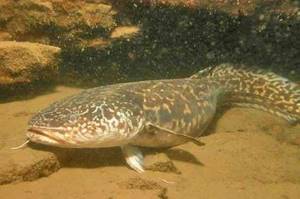
Immediately after the ice melts, spring fishing for this representative of cod begins.
What do burbot bite on in the spring?
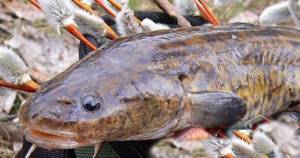
On some rivers of the Leningrad region, flowing into the Neva and Ladoga, bottoms are baited with great success with lamprey larvae (also known as squeaks, ganders and blind bindweeds). Moreover, you come across not only burbot, perch and pike, but also carp fish: ide, raw fish, bream. Sometimes you can use a blind bindweed to catch a large, one and a half kilogram, grayling going to spawn from Ladoga. The bindweed is planted by piercing the lip with one hook of a small tee (No. 6-No. 7), then the larva will not be able to burrow into muddy or sandy soil; In case of a pike bite, it is advisable to use a Kevlar leash.
Read also: Spicy salting of fish at home
It is possible to use cuttings from frozen capelin purchased in a store. However, the burbot bites worse on it than on cutting from a steaming, freshly caught fish. Sometimes - if I manage to get out for burbot only in the evening and there is no time left for catching live bait - I buy ruffe at fish stalls (in St. Petersburg they are caught by fishermen as bycatch when fishing for smelt, then they are re-sorted and sold at a symbolic price).
Burbot fishing in March
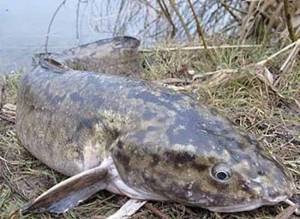
In each region, burbot fishing in March has its own characteristics. If there is strong ice, the same winter fishing for burbot continues. In such conditions, winter fishing rods are successfully used, and during active fishing, a winter fishing rod is used. During the freeze-up period, burbot is excellently caught using a snooker. Large jigs and spoons are used as bait. You can increase catchability by adding pieces of fish meat.
How to catch burbot in spring
Donks are installed secretly, tied to pegs stuck into the bottom near the shore so that the upper ends do not protrude above the water; The reel with excess fishing line is masked nearby. Fishermen who are not afraid of cold spring nights and stay overnight on the reservoir, next to the donks, cut sixes for them from thick rods and tie bell guards to the fishing line.
If you have to fish in too wide reservoirs and long casting is required, then spinning rods are equipped with burbot bottoms. In this case, a thinner line is used: the main line is 0.4 mm, the leads are 0.25 mm, and, naturally, the spinning rods are not left unattended at night.
Burbot fishing in April
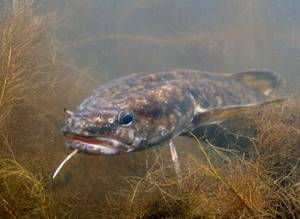
In April, weather conditions allow you to go on multi-day fishing trips without special winter equipment. But you need to be prepared for night frosts, although burbot fishing in April usually occurs at night, and a different time of day is chosen for rest (sleep).
It will take several days to successfully catch April burbot. First, the river or reservoir is examined. A fishing echo sounder is used to check the condition of the bottom. A tent is set up in the place chosen for fishing and live bait is caught. In April, the water is still quite cloudy, so you need to use small fish, about 10 cm, as live bait. Smaller fish are unlikely to attract the attention of a predator unless it accidentally gets under its nose. Fish that live in the same reservoir are excellent as live bait.
In the area chosen for burbot fishing, gear is installed during daylight hours. When placing live bait on an artificial bait or on a hook, you need to use a hook, as a result of which the hook tip remains open. When taking bait, burbot usually hooks itself. A hidden hook point can cause fish to escape. If the shore is clean and there is no coastal (shore) vegetation, then elastic fishing from the shore is successfully used. This tackle allows you to use several different baits at the same time. Using a rubber tackle allows you to brighten up the waiting time for a bite on stationary donks.
